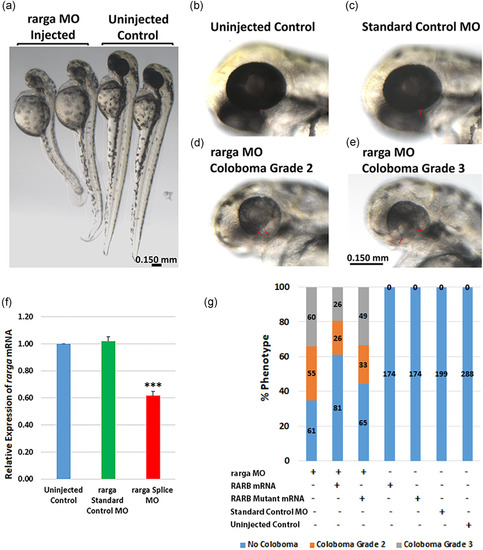- Title
-
High-throughput custom capture sequencing identifies novel mutations in coloboma-associated genes: Mutation in DNA-binding domain of retinoic acid receptor beta affects nuclear localization causing ocular coloboma
- Authors
- Kalaskar, V.K., Alur, R.P., Li, L.K., Thomas, J.W., Sergeev, Y.V., Blain, D., Hufnagel, R.B., Cogliati, T., Brooks, B.P.
- Source
- Full text @ Hum. Mutat.
|
Ocular coloboma phenotype and partial rescue in rarga morpholino (MO) knockdown zebrafish embryos. (a) rarga MO‐injected embryos show a slightly smaller body and head sizes compared with uninjected zebrafish embryos at 48 hr postfertilization (hpf). (b) Uninjected wild‐type with normal eye. (c) Standard control MO‐injected embryos. Ocular size is comparable to the wild‐type uninjected embryos and both reveal no coloboma in the eye or other phenotypes at 3.75–7.5 ng MO concentrations. (d–e) rarga MO‐injected embryos revealed concentration‐dependent ocular coloboma as Grade 2 (narrow, d) or Grade 3 (wide, e) optic fissure closure defects. The red bars indicate the margins of the optic fissure. Scale bar in (e) applies to panels b–e. (f) rarga transcript expression by qRT‐PCR was significantly reduced in MO knockdown zebrafish embryos; *** p < .001. (g) Human RARB mRNA but not RARB‐mutant mRNA partially reduced the coloboma phenotype in rarga MO knockdown embryos. Embryos were injected with rarga splice‐blocking MO along with either human wild‐type RARB or RARB‐mutant mRNA and coloboma phenotype was analyzed after 48 hpf. The values on the bars represent the number of embryos injected or analyzed. qRT‐PCR, quantitative real‐time polymerase chain reaction; mRNA, messenger RNA |

